Overview
- Brief Narrative
- Stitching awl wooden handle with fasteners to hold the needle used by Simon Gelbart, who was conscripted into the Soviet Army from 1943-1945 because of his shoemaking skills. Simon was a master shoemaker and kept his shoemaking kit with him all through the war. After Germany invaded Poland in September 1939, Simon kept moving his family, his wife, Sara, and sons David, 9, and Haim, 5, east to escape persecution. Soon after they reached Soviet territory, the family was arrested and sent to Siberian Labor Camp #70, where a daughter was born. When Germany invaded the Soviet Union in June 1941, they were released. Due to a bombing raid on their train, they were detained and that winter, the Soviets sent the family to Krotovka collective farm. Everything had been confiscated for the war effort and the farmers were Jew haters who would not help them. Haim died of starvation, but a devout Christian woman, Pashinka Bravina, took in David for 18 months. In 1943, Simon was forced to join the Red Army to repair shoes for the soldiers. He was stationed on the front lines and his family followed him until the war ended in May 1945. Simon was released from service in 1946 and the family returned to Łódź. Because of the vicious antisemitism there, Simon paid the underground to take them to west Germany where they were sent to Eschwege displaced persons camp. Denied permission to emigrate to Israel, the family went to the United States in 1951. Simon carried his shoemaking kit with him, but he never made shoes again.
- Date
-
use:
1925-1951
- Geography
-
use:
Soviet Union
use: Poland
- Credit Line
- United States Holocaust Memorial Museum Collection, Gift of David Gelbart
- Contributor
-
Subject:
Simon Gelbart
Subject: David Gelbart
- Biography
-
Simon Aaron Gelbart was born on March 15, 1908, in Warta, Poland, the youngest of thirteen children. His father, Israel David, was a prosperous orchard keeper and fur trader who died in 1915. Simon’s mother died soon after. None of Simon’s siblings, who had families of their own, took him in and 7 year old Simon became homeless and lived on the street. In 1923, Simon became an apprentice shoemaker to an Orthodox Jew, Zisha Nitka, in Kalisz, Poland. Simon married his daughter, Sura Rivka (Sara), in 1929. They lived and worked in a single basement room without running water or electricity. Sara bought old shoes from which they salvaged the leather and sold the scraps to other craftsman. Simon was well known for his high quality work making and repairing shoes. The couple had two sons, David, born September 17, 1930, and Haim, in 1934. The household was kept kosher, but Simon’s family was not Orthodox, although they observed the Sabbath and holidays. The family spoke Yiddish.
On September 1, 1939, Germany invaded Poland. The family fled, taking a baby carriage filled with belongings. Zisha, too old to run, stayed behind. The Polish Army set fire to anything that could be useful to the Germans. The family walked twenty miles to a small town where they stayed with Sara’s brother. A week later, the Germans ordered refugees to return home and the Gelbart’s returned to Kalisz. In January 1940, the Germans began to round-up Jews for deportation. They were held in an open area enclosed by a double barbed wire fence. When Simon learned that they were to be deported, he hollowed out the heels of everyone’s shoes to hide their money. The family was marched out of their home and the apartment sealed. Simon took his shoemaking tools and left a window open in case they needed to get back in. Once imprisoned, Simon realized that he had left his razor and sharpening stone behind. David escaped through a hole in the fence, returned and entered through the window. He retrieved the items and returned to the camp.
The family was deported to Warsaw and told they must move into the ghetto. Simon refused and the family took a train to Sompolno. Within a month, the Germans ordered the Jews into the ghetto. Again, Simon refused. They headed east, renting a horse and carriage at the next town. They were ferried across a river by smugglers, and, unable to afford a guide, followed a guided group. The next morning, they met a farmer took them to Russian occupied Siemiatycze (Semyatich). Zisha passed away. Simon worked as a shoemaker and Sara as a maid.
In 1940, two Jewish men with red armbands asked Simon to become a Russian citizen and he declined. Russian soldiers arrested the family. Simon took his shoemaking tools, and Sara, a can of seasoned beef fat. They were transported to Siberia and loaded onto horse pulled carts that ran on wooden rails. Prisoners coming from the opposite direction yelled at them to keep any edible plants they could find. The family arrived at Siberian Labor Camp #70 on the Volyshka River near the Arctic Circle. They lived in one room with wooden beds without bedding and a wood burning stove. There were no guards because there was nowhere to go. The boys attended a Russian school. Simon, ill from malnutrition and ung disease, cleaned stables and groomed the horses. Sara worked as a maid. During the Russo-Finnish war, November 30th, 1939-March 13th, 1940, the prisoners were forgotten and received one daily piece of bread. To feed the camp, Simon slaughtered horses from which the cooks made soup. He would sneak some meat and Sara cooked it in the beef fat. Simon was reassigned to hard labor cutting down trees and hauling wood. On his first day, he failed to make the quota and was imprisoned for six months. A pregnant Sara left to have her baby in the main camp, Labor Camp #1, leaving David and Haim alone until Simon’s release. Their daughter, Sina, was born prematurely, and with the lack of food, she became mentally handicapped. To survive, the starving family ate dead fish Simon found in the river.
On June 22, 1941, Germany invaded Russia. The family was released and left for Stalingrad. The Germans bombed the railroad and the family was detained in Kuibyshev. In the winter of 1942, the Russian government transferred them to the Krotovka collective farm on the Volga River near Ulianovsk. They lived in a large house without heat, electricity, or water, with another Jewish family. They had no food and the other farmers were Jew haters who refused to help. Haim died from starvation. Simon repaired shoes when scraps of leather could be found. The family moved to a smaller house that they shared with the Mida family. One day, Simon and Mida saw dogs eating horse carcasses near the stable. The farmers would not eat meat from animals that died from unknown causes, but Simon and Mida cut meat from the carcasses for their families. Everything from the farm had been confiscated by the government for the war effort. They were all ill from starvation. Sara used shoe wax to fry any scraps of food they found. David learned to make the sign of the cross and say “Christ has risen” and, on Christian holidays, went to villages and used his Christian gestures to beg for food. A devout Christian women, Pashinka Bravina, took David in and kept him fed regularly with milk and bread for eighteen months.
In late 1943, Simon was drafted into the Russian Workers Army to work in a government cartel repairing shoes for the soldiers. He lived with a communist Jewish family in Ulianovsk. Then he was sent to the frontlines near Odessa and the family followed. Simon worked after hours repairing shoes and Sara sold leather scraps. The extra money allowed David to go to the movies and the family to buy food. Simon stole enough leather to make fifteen year old David a pair of too large Russian style boots that David could wear for many years. The war ended in May 1945, and in 1946, the family was released and returned to Łódź. Antisemitism was prevalent and Simon felt it put his family at risk. He paid an underground Zionist group to help the family leave Poland for Germany. They were transported to Berlin by a Russian truck and driver. At the border of Russian occupied Berlin, the driver told the guard he was transporting German prisoners. The guard said they should be killed, but the driver gave him a bottle of vodka and some pork and the guard let them pass. The Gelbarts walked to the American zone and then were sent to Eschwege displaced persons camp. A son, Abraham, was born there on June 18, 1946. David went to auto mechanics school, joined a Zionist organization, and was recruited into Haganah, a defense organization active in the struggle for an independent state of Israel. Simon wanted to emigrate to Palestine and bought shoemaking equipment to open a shop. He found out that only David, as an able-bodied soldier, now in officer training school in France, was permitted to emigrate. Simon went to France and told David’s commanding officer that if David was to go to Palestine the whole family had to go. The commander said this was not possible and David returned to Germany. A few months later, the family received visas to emigrate to the United States. They arrived in New York in March 1951 and settled in Omaha, Nebraska. Simon sometimes repaired, but never made, another pair of shoes. Simon, 71, died of lung cancer on June 1, 1980, in Las Vegas, Nevada. Sara, 85, passed away on September 28, 1992, in Omaha.
David Gelbart was born in Kalisz, Poland, on September 17, 1930. His father, Simon, was born March 15, 1908, in Warta. His mother, Sara Nitka, was born March 12, 1907, in Łódź. Sarah was the daughter of Zisha Nitka, an Orthodox Jew who had taken Simon, a homeless teenager, into his home in 1923 and taught him the shoemaking trade. Simon was now a highly regarded craftsman. David’s brother, Haim, was born in 1934. The family was poor and often hungry. They lived with Zisha in one room, with no running water or electricity. They kept kosher, observed the Sabbath and holidays, and spoke Yiddish. David was tutored by a Yeshiva student. He often encountered antisemitism and other children beat him up for being Jewish. His father gave him cobblestones to use as weights to strengthen his arms, and taught him to fight back. When men at the market called David and his mother names in Polish and they returned insults in Yiddish.
After Germany invaded Poland on September 1, 1939, the family fled, without Zisha who was too old. Sara told the boys to close their eyes as they stepped over dead bodies while walking to her brother’s village. A week later, the Germans ordered refugees to return to their homes and the Gelbart’s returned to Kalisz. They wore Star of David armbands and David watched as Jewish owned stores were destroyed. German soldiers put cobble nails in their boot soles which made loud noises on the pavement as they marched. In January 1940, the Germans rounded up Jews and confined them in a double barbed wire enclosure. Learning they were to be deported, Simon hid their money in the hollowed soles of their shoes. The family was marched out under guard and the room sealed. Simon took his tools and Sara bedding. Once imprisoned, Simon realized that he had left his razor and sharpening stone. David slipped through a hole in the fence, returned to the room and crawled through the window. He retrieved the shaving kit and snuck back into jail.
The family was deported to Warsaw and told to move into the ghetto. Simon refused and they took a train to Sompolno. Within a month, the Germans ordered the Jews into the ghetto. Again, Simon refused. They headed east in a rented horse and carriage. With no money to hire a guide, the family followed a guided group. They met a farmer who took them to Russian occupied Siemiatycze, where Simon worked as a shoemaker and Sara as a maid. Zisha died here. In 1940, two Jewish men with red armbands asked Simon to become a Russian citizen and he declined. Russian soldiers arrested the family. Simon took his shoemaking tools, and Sara, a can of seasoned beef fat. They were transported to Siberia on horse pulled carts that ran on wooden rails. They were placed in Siberian Labor Camp #70 on the Volyshka River near the Arctic Circle. They lived in one room with wooden beds with no bedding and a wood burning stove. There were no guards because there was nowhere to go. David and Haim attended a Russian school. In the winter, David and Simon chopped ice from the frozen river for water. Simon worked in the stables. During the Russo-Finnish war, November 30th 1939 to March 13th, 1940, the prisoners were forgotten and got one daily piece of bread. To feed the camp, Simon slaughtered horses for the cooks. He would sneak meat home that Sara cooked in the beef fat. Simon was reassigned to cut down and haul trees. On his first day, he did not make the quota and was jailed for six months. A pregnant Sara left to have her baby in Labor Camp #1, leaving David and Haim alone until Simon’s release. David’s sister, Sina, was born prematurely, and the lack of food led to her becoming mentally disabled. To survive, the starving family ate dead fish from the river.
On June 22, 1941, Germany invaded Russia. The family was released and left for Stalingrad, but the Germans bombed the railroad and the family was detained in Kuibyshev. That winter, the Soviet government transferred them to Krotovka collective farm. They lived in a house without heat, electricity, or water, with another Jewish family. They had no food and the other farmers were Jew haters and would not help. Haim died of starvation while sleeping on the floor next to David. David attended school and was beaten for being Jewish. A devout Christian woman, Pashinka Bravina, lived alone across from the Gelbart home and she took David in and, with the aid of neighbors, regularly fed him milk and bread. His family moved to another house shared with the Mida family. One day, Simon and Mida saw dogs eating horse carcasses. The local farmers would not eat the meat from animals that died for unknown reasons. But Simon and Mida cut meat from the carcasses to feed their families. The government confiscated everything from the farm for the war effort and death by starvation was a close threat to them all. David ate grass and boiled pumpkin. In the winter, he dug up snow to look for potatoes missed during the harvest. He stole and ate grain used to feed the horses. Sara used the precious shoe wax to fry whatever scraps of food they found. David learned to make the sign of the cross and say “Christ has risen” and on holidays, would go to villages and beg for food using his Christian gestures.
In late 1943, the Soviet Army drafted Simon to repair shoes for the soldiers. When he was sent to the front in Odessa in 1945, the family followed. Simon worked after hours repairing shoes and Sara sold leather scraps. There was enough extra money for David to go to the movies. Simon stole enough leather to make fifteen year old David a pair of too large boots that David could wear for many years. The war ended in May 1945. Simon was released from service in 1946 and the family returned to Łódź. Antisemitism was prevalent and an underground Zionist group arranged for the family to leave Poland. They were transported to Berlin by a Russian truck and driver. When they arrived at the border of Russian occupied Berlin, the driver told the guard he was transporting German prisoners. The guard said they should be killed. The driver gave him a bottle of vodka and some pork and the guard let them pass. The family walked to the American occupied zone and was transported to Eschwege displaced persons camp. A brother, Abraham, was born there on June 18, 1946. David went to auto mechanics school, joined a Zionist organization, and was recruited into Haganah, a Palestinian defense organization active in the struggle for independence. He did weapons training in Bavaria and was sent to officer’s school in France. Simon wanted to emigrate to Palestine and bought shoemaking equipment to open a factory. He found out that only David was able to emigrate, so he went to France and told David’s commanding officer that if David was to go to Palestine the whole family had to go. The commander said this was not possible because only able-bodied soldiers were being issued visas. David returned to Germany.
A few months later they received visas to emigrate to the United States. Prior to leaving, David learned English from a tutor. They left Bremerhaven on the SS General CH Muir and arrived in New York in March 1951. They settled in Omaha, Nebraska. David was drafted into the US Army and returned to Germany to work as an interpreter. He later married. Simon would occasionally repair shoes, but the Russian boots he made for David were the last shoes he made. Simon, 71, died on June 1, 1980. Sara, 85, died on September 28, 1992, age 85, in Omaha.
Physical Details
- Language
- English
- Classification
-
Tools and Equipment
- Category
-
Shoemaking equipment and supplies
- Object Type
-
Handles (lcsh)
- Physical Description
- Dark brown, turned wooden handle into which is inserted a cylindrical, threaded, steel chuck onto which is screwed a circular, removable steel ferrule. The rounded handle bottom has remnants of reddish stain varnish and a small hole. The flared handle bottom narrows, bulges in the center, and narrows towards the top. The chuck tip has 4 teeth. The ferrule is separated into 2 diamond patterned bands by a smooth groove. The metal is corroded and the wood handle is split and darkly stained from use.
- Dimensions
- overall: Height: 3.625 inches (9.208 cm) | Width: 1.125 inches (2.858 cm) | Depth: 1.125 inches (2.858 cm)
- Materials
- overall : wood, metal, varnish stain
Rights & Restrictions
- Conditions on Access
- No restrictions on access
- Conditions on Use
- No restrictions on use
Keywords & Subjects
- Topical Term
- Holocaust, Jewish (1939-1945)--Poland--Personal narratives. Jewish refugees--Soviet Union--Biography. Shoemakers--Soviet Union--Biography. Forced labor--Soviet Union--Biography. World War, 1939-1945--Conscript labor--Soviet Union--Biography. World War, 1939-1945--Personal narratives, Jewish.
Administrative Notes
- Legal Status
- Permanent Collection
- Provenance
- The sewing awl handle was donated to the United States Holocaust Memorial Museum in 2004 by David Gelbart, the son of Simon Gelbart.
- Funding Note
- The cataloging of this artifact has been supported by a grant from the Conference on Jewish Material Claims Against Germany.
- Record last modified:
- 2022-08-30 12:32:12
- This page:
- https://collections.ushmm.org/search/catalog/irn522341
Download & Licensing
In-Person Research
- By Appointment
- Request 21 Days in Advance of Visit
- Plan a Research Visit
- Request to See This Object
Contact Us
Also in Simon Gelbart collection
The collection consists of shoemaking tools relating to the experiences of Simon Gelbart in Poland before the war and in Poland and the Soviet Union, including forced labor service with the Soviet Army, during World War II.
Date: 1930-1946
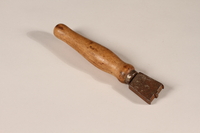
9/10 double edge iron shoemaking tool used by a Polish Jewish refugee conscripted as a shoemaker by the Soviet Army
Object
9/10 double edge iron shoemaking tool used by Simon Gelbart, who was conscripted into the Soviet Army from 1943-1945 because of his shoemaking skills. This burnishing tool is heated and heavily pressed along the edge of the shoe sole to strengthen the edge and seal it from water. There are several edge irons of different sizes and forms in his tool kit which Simon, a master shoemaker, kept with him all through the war. After Germany invaded Poland in September 1939, Simon kept moving his family, his wife, Sara, and sons David, 9, and Haim, 5, east to escape persecution. Soon after they reached Soviet territory, the family was arrested and sent to Siberian Labor Camp #70, where a daughter was born. When Germany invaded the Soviet Union in June 1941, they were released. Due to a bombing raid on their train, they were detained and that winter, the Soviets sent the family to Krotovka collective farm. Everything had been confiscated for the war effort and the farmers were Jew haters who would not help them. Haim died of starvation, but a devout Christian woman, Pashinka Bravina, took in David. In 1943, Simon was forced to join the Red Army to repair shoes for the soldiers. He was stationed on the front lines and his family followed him until the war ended in May 1945. Simon was released from service in 1946 and the family returned to Łódź. Because of the vicious antisemitism there, Simon paid the underground to take them to west Germany where they were sent to Eschwege displaced persons camp. Denied permission to emigrate to Israel, the family went to the United States in 1951. Simon carried his shoemaking kit with him, but he never made shoes again.
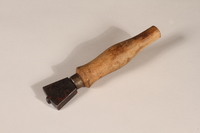
Edge iron shoemaking tool used by a Polish Jewish refugee conscripted as a shoemaker by the Soviet Army
Object
Edge iron shoemaking tool used by Simon Gelbart, who was conscripted into the Soviet Army from 1943-1945 because of his shoemaking skills. This burnishing tool is heated and heavily pressed along the edge of the shoe sole to strengthen the edge and seal it from water. There are several edge irons of different sizes and forms in his tool kit which Simon, a master shoemaker, kept with him all through the war. After Germany invaded Poland in September 1939, Simon kept moving his family, his wife, Sara, and sons David, 9, and Haim, 5, east to escape persecution. Soon after they reached Soviet territory, the family was arrested and sent to Siberian Labor Camp #70, where a daughter was born. When Germany invaded the Soviet Union in June 1941, they were released. Due to a bombing raid on their train, they were detained and that winter, the Soviets sent the family to Krotovka collective farm. Everything had been confiscated for the war effort and the farmers were Jew haters who would not help them. Haim died of starvation, but a devout Christian woman, Pashinka Bravina, took in David. In 1943, Simon was forced to join the Red Army to repair shoes for the soldiers. He was stationed on the front lines and his family followed him until the war ended in May 1945. Simon was released from service in 1946 and the family returned to Łódź. Because of the vicious antisemitism there, Simon paid the underground to take them to west Germany where they were sent to Eschwege displaced persons camp. Denied permission to emigrate to Israel, the family went to the United States in 1951. Simon carried his shoemaking kit with him, but he never made shoes again.
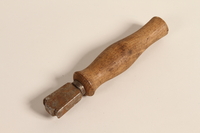
5/6 double edge iron shoemaking tool used by a Polish Jewish refugee conscripted as a shoemaker by the Soviet Army
Object
5/6 double edge iron shoemaking tool used by Simon Gelbart, who was conscripted into the Soviet Army from 1943-1945 because of his shoemaking skills. This burnishing tool is heated and heavily pressed along the edge of the shoe sole to strengthen the edge and seal it from water. There are several edge irons of different sizes and forms in his tool kit which Simon, a master shoemaker, kept with him all through the war. After Germany invaded Poland in September 1939, Simon kept moving his family, his wife, Sara, and sons David, 9, and Haim, 5, east to escape persecution. Soon after they reached Soviet territory, the family was arrested and sent to Siberian Labor Camp #70, where a daughter was born. When Germany invaded the Soviet Union in June 1941, they were released. Due to a bombing raid on their train, they were detained and that winter, the Soviets sent the family to Krotovka collective farm. Everything had been confiscated for the war effort and the farmers were Jew haters who would not help them. Haim died of starvation, but a devout Christian woman, Pashinka Bravina, took in David. In 1943, Simon was forced to join the Red Army to repair shoes for the soldiers. He was stationed on the front lines and his family followed him until the war ended in May 1945. Simon was released from service in 1946 and the family returned to Łódź. Because of the vicious antisemitism there, Simon paid the underground to take them to west Germany where they were sent to Eschwege displaced persons camp. Denied permission to emigrate to Israel, the family went to the United States in 1951. Simon carried his shoemaking kit with him, but he never made shoes again.
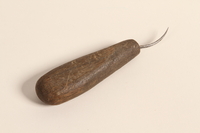
Curved needle stitching awl used by a Polish Jewish refugee conscripted as a shoemaker by the Soviet Army
Object
Wooden handled stitching awl with a curved needle used by Simon Gelbart, who was conscripted into the Soviet Army from 1943-1945 because of his shoemaking skills. Simon was a master shoemaker and kept his shoemaking kit with him all through the war. After Germany invaded Poland in September 1939, Simon kept moving his family, his wife, Sara, and sons David, 9, and Haim, 5, east to escape persecution. Soon after they reached Soviet territory, the family was arrested and sent to Siberian Labor Camp #70, where a daughter was born. When Germany invaded the Soviet Union in June 1941, they were released. Due to a bombing raid on their train, they were detained and that winter, the Soviets sent the family to Krotovka collective farm. Everything had been confiscated for the war effort and the farmers were Jew haters who would not help them. Haim died of starvation, but a devout Christian woman, Pashinka Bravina, took in David. In 1943, Simon was forced to join the Red Army to repair shoes for the soldiers. He was stationed on the front lines and his family followed him until the war ended in May 1945. Simon was released from service in 1946 and the family returned to Łódź. Because of the vicious antisemitism there, Simon paid the underground to take them to west Germany where they were sent to Eschwege displaced persons camp. Denied permission to emigrate to Israel, the family went to the United States in 1951. Simon carried his shoemaking kit with him, but he never made shoes again.
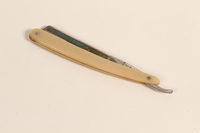
Straight razor with an offwhite plastic handle used by a Polish Jewish refugee conscripted as a shoemaker by the Soviet Army
Object
Straight razor with a plastic handle used by Simon Gelbart, who was conscripted into the Soviet Army from 1943-1945 because of his shoemaking skills. In January 1940, after the Germans detained the family within a barbed wire enclosure for deportation from Kalisz, Poland, Simon realized he had forgotten his razor and whetstone. His 9 year son David snuck through the fence, into their boarded up house, and then back into the prison with the retrieved items. Simon was a master shoemaker and kept his shoemaking kit with him all through the war. After Germany invaded Poland in September 1939, Simon kept moving his family, his wife, Sara, and sons David, 9, and Haim, 5, east to escape persecution. Soon after they reached Soviet territory, the family was arrested and sent to Siberian Labor Camp #70, where a daughter was born. When Germany invaded the Soviet Union in June 1941, they were released. Due to a bombing raid on their train, they were detained and that winter, the Soviets sent the family to Krotovka collective farm. Everything had been confiscated for the war effort and the farmers were Jew haters who would not help them. Haim died of starvation, but a devout Christian woman, Pashinka Bravina, took in David for 18 months. In 1943, Simon was forced to join the Red Army to repair shoes for the soldiers. He was stationed on the front lines and his family followed him until the war ended in May 1945. Simon was released from service in 1946 and the family returned to Łódź. Because of the vicious antisemitism there, Simon paid the underground to take them to west Germany where they were sent to Eschwege displaced persons camp. Denied permission to emigrate to Israel, the family went to the United States in 1951. Simon carried his shoemaking kit with him, but he never made shoes again.
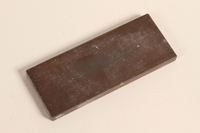
Dark brown whetstone used by a Polish Jewish refugee conscripted as a shoemaker by the Soviet Army
Object
Dark brown sharpening stone used by Simon Gelbart, who was conscripted into the Soviet Army from 1943-1945 because of his shoemaking skills. In January 1940, after the Germans detained the family within a barbed wire enclosure for deportation from Kalisz, Poland, Simon realized he had forgotten his razor and whetstone. His 9 year son David snuck through the fence, into their boarded up house, and then back into the prison with the retrieved items. Simon was a master shoemaker and kept his shoemaking kit with him all through the war. After Germany invaded Poland in September 1939, Simon kept moving his family, his wife, Sara, and sons David, 9, and Haim, 5, east to escape persecution. Soon after they reached Soviet territory, the family was arrested and sent to Siberian Labor Camp #70, where a daughter was born. When Germany invaded the Soviet Union in June 1941, they were released. Due to a bombing raid on their train, they were detained and that winter, the Soviets sent the family to Krotovka collective farm. Everything had been confiscated for the war effort and the farmers were Jew haters who would not help them. Haim died of starvation, but a devout Christian woman, Pashinka Bravina, took in David for 18 months. In 1943, Simon was forced to join the Red Army to repair shoes for the soldiers. He was stationed on the front lines and his family followed him until the war ended in May 1945. Simon was released from service in 1946 and the family returned to Łódź. Because of the vicious antisemitism there, Simon paid the underground to take them to west Germany where they were sent to Eschwege displaced persons camp. Denied permission to emigrate to Israel, the family went to the United States in 1951. Simon carried his shoemaking kit with him, but he never made shoes again.
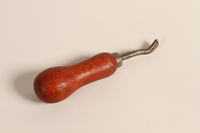
Leather creaser used by a Polish Jewish refugee conscripted as a shoemaker by the Soviet Army
Object
Leather creasing tool used by Simon Gelbart, who was conscripted into the Soviet Army from 1943-1945 because of his shoemaking skills. Simon was a master shoemaker and kept his shoemaking kit with him all through the war. After Germany invaded Poland in September 1939, Simon kept moving his family, his wife, Sara, and sons David, 9, and Haim, 5, east to escape persecution. Soon after they reached Soviet territory, the family was arrested and sent to Siberian Labor Camp #70, where a daughter was born. When Germany invaded the Soviet Union in June 1941, they were released. Due to a bombing raid on their train, they were detained and that winter, the Soviets sent the family to Krotovka collective farm. Everything had been confiscated for the war effort and the farmers were Jew haters who would not help them. Haim died of starvation, but a devout Christian woman, Pashinka Bravina, took in David for 18 months. In 1943, Simon was forced to join the Red Army to repair shoes for the soldiers. He was stationed on the front lines and his family followed him until the war ended in May 1945. Simon was released from service in 1946 and the family returned to Łódź. Because of the vicious antisemitism there, Simon paid the underground to take them to west Germany where they were sent to Eschwege displaced persons camp. Denied permission to emigrate to Israel, the family went to the United States in 1951. Simon carried his shoemaking kit with him, but he never made shoes again.
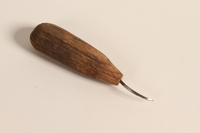
Stitching awl with a 1 inch curved needle used by a Polish Jewish refugee conscripted as a shoemaker by the Soviet Army
Object
Wooden handled curved 1 inch stitching awl used by Simon Gelbart, who was conscripted into the Soviet Army from 1943-1945 because of his shoemaking skills. Simon was a master shoemaker and kept his shoemaking kit with him all through the war. After Germany invaded Poland in September 1939, Simon kept moving his family, his wife, Sara, and sons David, 9, and Haim, 5, east to escape persecution. Soon after they reached Soviet territory, the family was arrested and sent to Siberian Labor Camp #70, where a daughter was born. When Germany invaded the Soviet Union in June 1941, they were released. Due to a bombing raid on their train, they were detained and that winter, the Soviets sent the family to Krotovka collective farm. Everything had been confiscated for the war effort and the farmers were Jew haters who would not help them. Haim died of starvation, but a devout Christian woman, Pashinka Bravina, took in David for 18 months. In 1943, Simon was forced to join the Red Army to repair shoes for the soldiers. He was stationed on the front lines and his family followed him until the war ended in May 1945. Simon was released from service in 1946 and the family returned to Łódź. Because of the vicious antisemitism there, Simon paid the underground to take them to west Germany where they were sent to Eschwege displaced persons camp. Denied permission to emigrate to Israel, the family went to the United States in 1951. Simon carried his shoemaking kit with him, but he never made shoes again.
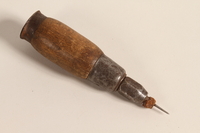
Straight half inch stitching awl used by a Polish Jewish refugee conscripted as a shoemaker by the Soviet Army
Object
Wooden handled straight .5 inch needle stitching awl with metal chuck used by Simon Gelbart, who was conscripted into the Soviet Army from 1943-1945 because of his shoemaking skills. Simon was a master shoemaker and kept his shoemaking kit with him all through the war. After Germany invaded Poland in September 1939, Simon kept moving his family, his wife, Sara, and sons David, 9, and Haim, 5, east to escape persecution. Soon after they reached Soviet territory, the family was arrested and sent to Siberian Labor Camp #70, where a daughter was born. When Germany invaded the Soviet Union in June 1941, they were released. Due to a bombing raid on their train, they were detained and that winter, the Soviets sent the family to Krotovka collective farm. Everything had been confiscated for the war effort and the farmers were Jew haters who would not help them. Haim died of starvation, but a devout Christian woman, Pashinka Bravina, took in David for 18 months. In 1943, Simon was forced to join the Red Army to repair shoes for the soldiers. He was stationed on the front lines and his family followed him until the war ended in May 1945. Simon was released from service in 1946 and the family returned to Łódź. Because of the vicious antisemitism there, Simon paid the underground to take them to west Germany where they were sent to Eschwege displaced persons camp. Denied permission to emigrate to Israel, the family went to the United States in 1951. Simon carried his shoemaking kit with him, but he never made shoes again.
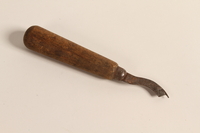
Leather creaser with a curved needle point head used by a Polish Jewish refugee conscripted as a shoemaker by the Soviet Army
Object
Wooden handled leather creasing tool with an S-curved, needle tipped head used by Simon Gelbart, who was conscripted into the Soviet Army from 1943-1945 because of his shoemaking skills. Simon was a master shoemaker and kept his shoemaking kit with him all through the war. After Germany invaded Poland in September 1939, Simon kept moving his family, his wife, Sara, and sons David, 9, and Haim, 5, east to escape persecution. Soon after they reached Soviet territory, the family was arrested and sent to Siberian Labor Camp #70, where a daughter was born. When Germany invaded the Soviet Union in June 1941, they were released. Due to a bombing raid on their train, they were detained and that winter, the Soviets sent the family to Krotovka collective farm. Everything had been confiscated for the war effort and the farmers were Jew haters who would not help them. Haim died of starvation, but a devout Christian woman, Pashinka Bravina, took in David for 18 months. In 1943, Simon was forced to join the Red Army to repair shoes for the soldiers. He was stationed on the front lines and his family followed him until the war ended in May 1945. Simon was released from service in 1946 and the family returned to Łódź. Because of the vicious antisemitism there, Simon paid the underground to take them to west Germany where they were sent to Eschwege displaced persons camp. Denied permission to emigrate to Israel, the family went to the United States in 1951. Simon carried his shoemaking kit with him, but he never made shoes again.
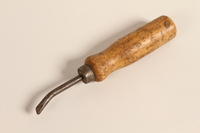
Leather creaser with an grooved head engraved 6 used by a Polish Jewish refugee conscripted as a shoemaker by the Soviet Army
Object
Leather creasing tool with 6 engraved on the angled head used by Simon Gelbart, who was conscripted into the Soviet Army from 1943-1945 because of his shoemaking skills. Simon was a master shoemaker and kept his shoemaking kit with him all through the war. After Germany invaded Poland in September 1939, Simon kept moving his family, his wife, Sara, and sons David, 9, and Haim, 5, east to escape persecution. Soon after they reached Soviet territory, the family was arrested and sent to Siberian Labor Camp #70, where a daughter was born. When Germany invaded the Soviet Union in June 1941, they were released. Due to a bombing raid on their train, they were detained and that winter, the Soviets sent the family to Krotovka collective farm. Everything had been confiscated for the war effort and the farmers were Jew haters who would not help them. Haim died of starvation, but a devout Christian woman, Pashinka Bravina, took in David for 18 months. In 1943, Simon was forced to join the Red Army to repair shoes for the soldiers. He was stationed on the front lines and his family followed him until the war ended in May 1945. Simon was released from service in 1946 and the family returned to Łódź. Because of the vicious antisemitism there, Simon paid the underground to take them to west Germany where they were sent to Eschwege displaced persons camp. Denied permission to emigrate to Israel, the family went to the United States in 1951. Simon carried his shoemaking kit with him, but he never made shoes again.
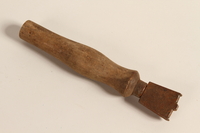
12/14 double edge iron shoemaking tool used by a Polish Jewish refugee conscripted as a shoemaker by the Soviet Army
Object
12/14 double edge iron shoemaking tool used by Simon Gelbart, who was conscripted into the Soviet Army from 1943-1945 because of his shoemaking skills. This burnishing tool is heated and heavily pressed along the edge of the shoe sole to strengthen the edge and seal it from water. There are several edge irons of different sizes and forms in his tool kit which Simon, a master shoemaker, kept with him all through the war. After Germany invaded Poland in September 1939, Simon kept moving his family, his wife, Sara, and sons David, 9, and Haim, 5, east to escape persecution. Soon after they reached Soviet territory, the family was arrested and sent to Siberian Labor Camp #70, where a daughter was born. When Germany invaded the Soviet Union in June 1941, they were released. Due to a bombing raid on their train, they were detained and that winter, the Soviets sent the family to Krotovka collective farm. Everything had been confiscated for the war effort and the farmers were Jew haters who would not help them. Haim died of starvation, but a devout Christian woman, Pashinka Bravina, took in David. In 1943, Simon was forced to join the Red Army to repair shoes for the soldiers. He was stationed on the front lines and his family followed him until the war ended in May 1945. Simon was released from service in 1946 and the family returned to Łódź. Because of the vicious antisemitism there, Simon paid the underground to take them to west Germany where they were sent to Eschwege displaced persons camp. Denied permission to emigrate to Israel, the family went to the United States in 1951. Simon carried his shoemaking kit with him, but he never made shoes again.
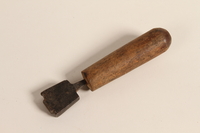
Dark gray edge iron shoemaking tool used by a Polish Jewish refugee conscripted as a shoemaker by the Soviet Army
Object
Edge iron shoemaking tool with a half inch top wedge used by Simon Gelbart, who was conscripted into the Soviet Army from 1943-1945 because of his shoemaking skills. This burnishing tool is heated and heavily pressed along the edge of the shoe sole to strengthen the edge and seal it from water. There are several edge irons of different sizes and forms in his tool kit which Simon, a master shoemaker, kept with him all through the war. After Germany invaded Poland in September 1939, Simon kept moving his family, his wife, Sara, and sons David, 9, and Haim, 5, east to escape persecution. Soon after they reached Soviet territory, the family was arrested and sent to Siberian Labor Camp #70, where a daughter was born. When Germany invaded the Soviet Union in June 1941, they were released. Due to a bombing raid on their train, they were detained and that winter, the Soviets sent the family to Krotovka collective farm. Everything had been confiscated for the war effort and the farmers were Jew haters who would not help them. Haim died of starvation, but a devout Christian woman, Pashinka Bravina, took in David. In 1943, Simon was forced to join the Red Army to repair shoes for the soldiers. He was stationed on the front lines and his family followed him until the war ended in May 1945. Simon was released from service in 1946 and the family returned to Łódź. Because of the vicious antisemitism there, Simon paid the underground to take them to west Germany where they were sent to Eschwege displaced persons camp. Denied permission to emigrate to Israel, the family went to the United States in 1951. Simon carried his shoemaking kit with him, but he never made shoes again.
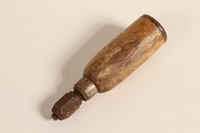
Wooden awl haft with chuck used by a Polish Jewish refugee conscripted as a shoemaker by the Soviet Army
Object
Wooden stitching awl handle with chuck which would hold a stitching needle used by Simon Gelbart, who was conscripted into the Soviet Army from 1943-1945 because of his shoemaking skills. Simon was a master shoemaker and kept his shoemaking kit with him all through the war. After Germany invaded Poland in September 1939, Simon kept moving his family, his wife, Sara, and sons David, 9, and Haim, 5, east to escape persecution. Soon after they reached Soviet territory, the family was arrested and sent to Siberian Labor Camp #70, where a daughter was born. When Germany invaded the Soviet Union in June 1941, they were released. Due to a bombing raid on their train, they were detained and that winter, the Soviets sent the family to Krotovka collective farm. Everything had been confiscated for the war effort and the farmers were Jew haters who would not help them. Haim died of starvation, but a devout Christian woman, Pashinka Bravina, took in David for 18 months. In 1943, Simon was forced to join the Red Army to repair shoes for the soldiers. He was stationed on the front lines and his family followed him until the war ended in May 1945. Simon was released from service in 1946 and the family returned to Łódź. Because of the vicious antisemitism there, Simon paid the underground to take them to west Germany where they were sent to Eschwege displaced persons camp. Denied permission to emigrate to Israel, the family went to the United States in 1951. Simon carried his shoemaking kit with him, but he never made shoes again.
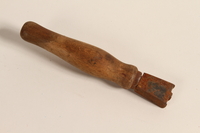
7/8 double edge iron shoemaking tool used by a Polish Jewish refugee conscripted as a shoemaker by the Soviet Army
Object
7/8 edge iron shoemaking tool with a half inch top wedge used by Simon Gelbart, who was conscripted into the Soviet Army from 1943-1945 because of his shoemaking skills. This burnishing tool is heated and heavily pressed along the edge of the shoe sole to strengthen the edge and seal it from water. There are several edge irons of different sizes and forms in his tool kit which Simon, a master shoemaker, kept with him all through the war. After Germany invaded Poland in September 1939, Simon kept moving his family, his wife, Sara, and sons David, 9, and Haim, 5, east to escape persecution. Soon after they reached Soviet territory, the family was arrested and sent to Siberian Labor Camp #70, where a daughter was born. When Germany invaded the Soviet Union in June 1941, they were released. Due to a bombing raid on their train, they were detained and that winter, the Soviets sent the family to Krotovka collective farm. Everything had been confiscated for the war effort and the farmers were Jew haters who would not help them. Haim died of starvation, but a devout Christian woman, Pashinka Bravina, took in David. In 1943, Simon was forced to join the Red Army to repair shoes for the soldiers. He was stationed on the front lines and his family followed him until the war ended in May 1945. Simon was released from service in 1946 and the family returned to Łódź. Because of the vicious antisemitism there, Simon paid the underground to take them to west Germany where they were sent to Eschwege displaced persons camp. Denied permission to emigrate to Israel, the family went to the United States in 1951. Simon carried his shoemaking kit with him, but he never made shoes again.
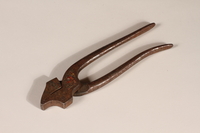
Steel pliers used by a Polish Jewish refugee conscripted as a shoemaker by the Soviet Army
Object
Steel pliers used by Simon Gelbart, who was conscripted into the Soviet Army from 1943-1945 because of his shoemaking skills. Simon was a master shoemaker and kept his shoemaking kit with him all through the war. After Germany invaded Poland in September 1939, Simon kept moving his family, his wife, Sara, and sons David, 9, and Haim, 5, east to escape persecution. Soon after they reached Soviet territory, the family was arrested and sent to Siberian Labor Camp #70, where a daughter was born. When Germany invaded the Soviet Union in June 1941, they were released. Due to a bombing raid on their train, they were detained and that winter, the Soviets sent the family to Krotovka collective farm. Everything had been confiscated for the war effort and the farmers were Jew haters who would not help them. Haim died of starvation, but a devout Christian woman, Pashinka Bravina, took in David for 18 months. In 1943, Simon was forced to join the Red Army to repair shoes for the soldiers. He was stationed on the front lines and his family followed him until the war ended in May 1945. Simon was released from service in 1946 and the family returned to Łódź. Because of the vicious antisemitism there, Simon paid the underground to take them to west Germany where they were sent to Eschwege displaced persons camp. Denied permission to emigrate to Israel, the family went to the United States in 1951. Simon carried his shoemaking kit with him, but he never made shoes again.
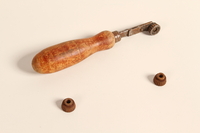
Embossing tool with 3 wheel attachments used by a Polish Jewish refugee conscripted as a shoemaker by the Soviet Army
Object
Embossing tool with a 2 piece wooden handle with a removable hollow base and three fluted wheel carriage attachments used by Simon Gelbart, who was conscripted into the Soviet Army from 1943-1945 because of his shoemaking skills. Simon was a master shoemaker and kept his shoemaking kit with him all through the war. After Germany invaded Poland in September 1939, Simon kept moving his family, his wife, Sara, and sons David, 9, and Haim, 5, east to escape persecution. Soon after they reached Soviet territory, the family was arrested and sent to Siberian Labor Camp #70, where a daughter was born. When Germany invaded the Soviet Union in June 1941, they were released. Due to a bombing raid on their train, they were detained and that winter, the Soviets sent the family to Krotovka collective farm. Everything had been confiscated for the war effort and the farmers were Jew haters who would not help them. Haim died of starvation, but a devout Christian woman, Pashinka Bravina, took in David for 18 months. In 1943, Simon was forced to join the Red Army to repair shoes for the soldiers. He was stationed on the front lines and his family followed him until the war ended in May 1945. Simon was released from service in 1946 and the family returned to Łódź. Because of the vicious antisemitism there, Simon paid the underground to take them to west Germany where they were sent to Eschwege displaced persons camp. Denied permission to emigrate to Israel, the family went to the United States in 1951. Simon carried his shoemaking kit with him, but he never made shoes again.
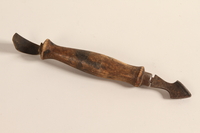
Leather creaser with a pointed triangular head used by a Polish Jewish refugee conscripted as a shoemaker by the Soviet Army
Object
Arrow shaped leather creasing tool used by Simon Gelbart, who was conscripted into the Soviet Army from 1943-1945 because of his shoemaking skills. Simon was a master shoemaker and kept his shoemaking kit with him all through the war. After Germany invaded Poland in September 1939, Simon kept moving his family, his wife, Sara, and sons David, 9, and Haim, 5, east to escape persecution. Soon after they reached Soviet territory, the family was arrested and sent to Siberian Labor Camp #70, where a daughter was born. When Germany invaded the Soviet Union in June 1941, they were released. Due to a bombing raid on their train, they were detained and that winter, the Soviets sent the family to Krotovka collective farm. Everything had been confiscated for the war effort and the farmers were Jew haters who would not help them. Haim died of starvation, but a devout Christian women took in David. In 1943, Simon was forced to join the Red Army to repair shoes for the soldiers. He was stationed on the front lines and his family followed him until the war ended in May 1945. Simon was released from service in 1946 and the family returned to Łódź. Because of the vicious antisemitism there, Simon paid the underground to take them to west Germany where they were sent to Eschwege displaced persons camp. Denied permission to emigrate to Israel, the family went to the United States in 1951. Simon carried his shoemaking kit with him, but he never made shoes again.
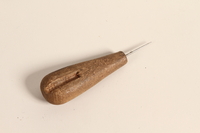
Stitching awl with a 1.25 inch needle used by a Polish Jewish refugee conscripted as a shoemaker by the Soviet Army
Object
Wooden handled stitching awl with a 1.25 inch needle used by Simon Gelbart, who was conscripted into the Soviet Army from 1943-1945 because of his shoemaking skills. Simon was a master shoemaker and kept his shoemaking kit with him all through the war. After Germany invaded Poland in September 1939, Simon kept moving his family, his wife, Sara, and sons David, 9, and Haim, 5, east to escape persecution. Soon after they reached Soviet territory, the family was arrested and sent to Siberian Labor Camp #70, where a daughter was born. When Germany invaded the Soviet Union in June 1941, they were released. Due to a bombing raid on their train, they were detained and that winter, the Soviets sent the family to Krotovka collective farm. Everything had been confiscated for the war effort and the farmers were Jew haters who would not help them. Haim died of starvation, but a devout Christian women took in David. In 1943, Simon was forced to join the Red Army to repair shoes for the soldiers. He was stationed on the front lines and his family followed him until the war ended in May 1945. Simon was released from service in 1946 and the family returned to Łódź. Because of the vicious antisemitism there, Simon paid the underground to take them to West Germany where they were sent to Eschwege displaced persons camp. Denied permission to emigrate to Israel, the family went to the United States in 1951. Simon carried his shoemaking kit with him, but he never made shoes again.
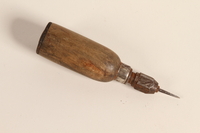
Straight needle awl with an .875 inch needle used by a Polish Jewish refugee conscripted as a shoemaker by the Soviet Army
Object
Straight awl needle used by Simon Gelbart, who was conscripted into the Soviet Army from 1943-1945 because of his shoemaking skills. Simon was a master shoemaker and kept his shoemaking kit with him all through the war. After Germany invaded Poland in September 1939, Simon kept moving his family, his wife, Sara, and sons David, 9, and Haim, 5, east to escape persecution. Soon after they reached Soviet territory, the family was arrested and sent to Siberian Labor Camp #70, where a daughter was born. When Germany invaded the Soviet Union in June 1941, they were released. Due to a bombing raid on their train, they were detained and that winter, the Soviets sent the family to Krotovka collective farm. Everything had been confiscated for the war effort and the farmers were Jew haters who would not help them. Haim died of starvation, but a devout Christian women took in David. In 1943, Simon was forced to join the Red Army to repair shoes for the soldiers. He was stationed on the front lines and his family followed him until the war ended in May 1945. Simon was released from service in 1946 and the family returned to Łódź. Because of the vicious antisemitism there, Simon paid the underground to take them to West Germany where they were sent to Eschwege displaced persons camp. Denied permission to emigrate to Israel, the family went to the United States in 1951. Simon carried his shoemaking kit with him, but he never made shoes again.
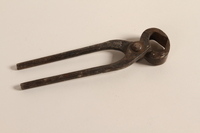
Cutting nippers used by a Polish Jewish refugee conscripted as a shoemaker by the Soviet Army
Object
Cutting nippers used by Simon Gelbart, who was conscripted into the Soviet Army from 1943-1945 because of his shoemaking skills. Simon was a master shoemaker and kept his shoemaking kit with him all through the war. After Germany invaded Poland in September 1939, Simon kept moving his family, his wife, Sara, and sons David, 9, and Haim, 5, east to escape persecution. Soon after they reached Soviet territory, the family was arrested and sent to Siberian Labor Camp #70, where a daughter was born. When Germany invaded the Soviet Union in June 1941, they were released. Due to a bombing raid on their train, they were detained and that winter, the Soviets sent the family to Krotovka collective farm. Everything had been confiscated for the war effort and the farmers were Jew haters who would not help them. Haim died of starvation, but a devout Christian women took in David. In 1943, Simon was forced to join the Red Army to repair shoes for the soldiers. He was stationed on the front lines and his family followed him until the war ended in May 1945. Simon was released from service in 1946 and the family returned to Łódź. Because of the vicious antisemitism there, Simon paid the underground to take them to west Germany where they were sent to Eschwege displaced persons camp. Denied permission to emigrate to Israel, the family went to the United States in 1951. Simon carried his shoemaking kit with him, but he never made shoes again.
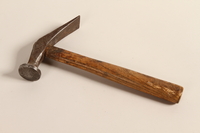
Cobbler's hammer used by a Polish Jewish refugee conscripted as a shoemaker by the Soviet Army
Object
Cobbler's hammer used by Simon Gelbart, who was conscripted into the Soviet Army from 1943-1945 because of his shoemaking skills. Simon was a master shoemaker and kept his shoemaking kit with him all through the war. After Germany invaded Poland in September 1939, Simon kept moving his family, his wife, Sara, and sons David, 9, and Haim, 5, east to escape persecution. Soon after they reached Soviet territory, the family was arrested and sent to Siberian Labor Camp #70, where a daughter was born. When Germany invaded the Soviet Union in June 1941, they were released. Due to a bombing raid on their train, they were detained and that winter, the Soviets sent the family to Krotovka collective farm. Everything had been confiscated for the war effort and the farmers were Jew haters who would not help them. Haim died of starvation, but a devout Christian women took in David. In 1943, Simon was forced to join the Red Army to repair shoes for the soldiers. He was stationed on the front lines and his family followed him until the war ended in May 1945. Simon was released from service in 1946 and the family returned to Łódź. Because of the vicious antisemitism there, Simon paid the underground to take them to West Germany where they were sent to Eschwege displaced persons camp. Denied permission to emigrate to Israel, the family went to the United States in 1951. Simon carried his shoemaking kit with him, but he never made shoes again.
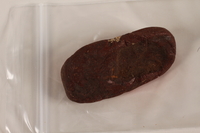
Dark red shoe wax used by a Polish Jewish refugee conscripted as a shoemaker by the Soviet Army
Object
Dark red shoe wax used by Simon Gelbart, who was conscripted into the Soviet Army from 1943-1945 because of his shoemaking skills. He used the wax to coat threads and seal edges to prevent moisture leaks. During the war, when the family was starving in Russia, Simon's wife used some as a replacement for cooking fat. Simon was a master shoemaker and kept his shoemaking kit with him all through the war. After Germany invaded Poland in September 1939, Simon kept moving his family, his wife, Sara, and sons David, 9, and Haim, 5, east to escape persecution. Soon after they reached Soviet territory, the family was arrested and sent to Siberian Labor Camp #70, where a daughter was born. When Germany invaded the Soviet Union in June 1941, they were released. Due to a bombing raid on their train, they were detained and that winter, the Soviets sent the family to Krotovka collective farm. Everything had been confiscated for the war effort and the farmers were Jew haters who would not help them. Haim died of starvation, but a devout Christian women took in David. In 1943, Simon was forced to join the Red Army to repair shoes for the soldiers. He was stationed on the front lines and his family followed him until the war ended in May 1945. Simon was released from service in 1946 and the family returned to Łódź. Because of the vicious antisemitism there, Simon paid the underground to take them to West Germany where they were sent to Eschwege displaced persons camp. Denied permission to emigrate to Israel, the family went to the United States in 1951. Simon carried his shoemaking kit with him, but he never made shoes again.
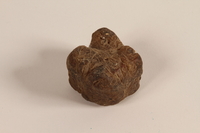
Brown shoe wax used by a Polish Jewish refugee conscripted as a shoemaker by the Soviet Army
Object
Brown shoe wax used by Simon Gelbart, who was conscripted into the Soviet Army from 1943-1945 because of his shoemaking skills. He used the wax to coat threads and seal edges to prevent moisture leaks. During the war, when the family was starving in Russia, Simon's wife used some as a replacement for cooking fat. Simon was a master shoemaker and kept his shoemaking kit with him all through the war. After Germany invaded Poland in September 1939, Simon kept moving his family, his wife, Sara, and sons David, 9, and Haim, 5, east to escape persecution. Soon after they reached Soviet territory, the family was arrested and sent to Siberian Labor Camp #70, where a daughter was born. When Germany invaded the Soviet Union in June 1941, they were released. Due to a bombing raid on their train, they were detained and that winter, the Soviets sent the family to Krotovka collective farm. Everything had been confiscated for the war effort and the farmers were Jew haters who would not help them. Haim died of starvation, but a devout Christian women took in David. In 1943, Simon was forced to join the Red Army to repair shoes for the soldiers. He was stationed on the front lines and his family followed him until the war ended in May 1945. Simon was released from service in 1946 and the family returned to Łódź. Because of the vicious antisemitism there, Simon paid the underground to take them to West Germany where they were sent to Eschwege displaced persons camp. Unable to emigrate to Israel, the family went to the United States in 1951. Simon carried his shoemaking kit with him, but he never made shoes again.



